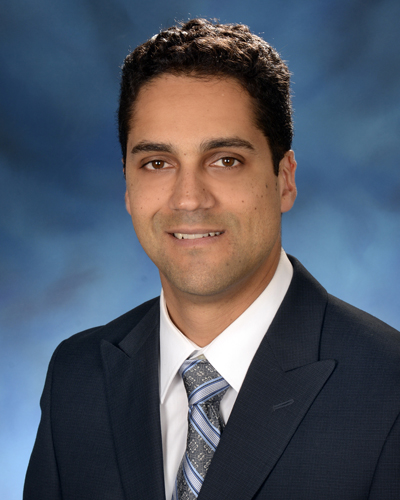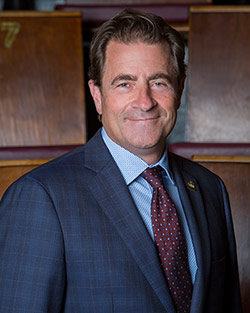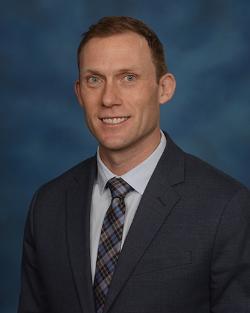�������� — Hip fractures in older adults can lead to serious complications, disability and even death. Traditionally, orthopaedic surgeons have repaired a common fracture of the upper part of the thigh bone, or femur, near the hip using screws and plates to piece together slightly separated pieces of bone. But many surgeons now treat these “minimally displaced” femoral neck fractures by replacing the hip joint with a metal implant.

A new $10.8 million multicenter clinical trial co-led by , an Associate Professor of Orthopaedics and Director of Clinical Research in the Department of Orthopaedics at the University of Maryland School of Medicine (UMSOM), will determine if hip replacement surgery, also known as hip arthroplasty, produces better outcomes for patients ages 60 and older than simpler “internal fixation” that has been performed for decades.
“Our goal is to improve patient outcomes after often debilitating hip fractures, especially among older adults,” said Dr. Slobogean who is also an orthopaedic trauma surgeon at the R Adams Cowley Shock Trauma Center at the University of Maryland Medical Center (UMMC). “Hip fractures are a major public health concern, and we anticipate that the results of this trial will definitively inform clinical practice, regardless of the result.”
Each year, more than 5 million older adults around the world sustain hip fractures. Femoral neck fractures are very common, and one in five of those fractures are considered minimally displaced, with a small gap between the edges of the broken bone. About 14 percent of those who receive internal fixation surgery ultimately need to have another surgery, such as a hip replacement.
“We want to answer the question, ‘When an older adult has this type of broken hip, does fixing the fracture or replacing the hip best reduce death, maintain their ability to walk, increase their time at home and improve their overall health?’” Dr. Slobogean said. “Currently, we have limited clinical research to help patients, caregivers and orthopaedic surgeons choose the best treatment for each patient.”
Researchers expect to open the randomized controlled clinical trial in the fall. They plan to enroll 600 patients age 60 or older who need surgery for minimally displaced femoral neck fractures, at 32 tertiary care and community hospitals in the United States, Canada, the United Kingdom, Spain, the Netherlands and Norway. The R Adams Cowley Shock Trauma Center – the highest-level trauma center in Maryland – will be one of the sites. Patients will be randomly selected to receive either internal fixation or hip replacement surgery and investigators will follow them for 12 months.
The “FASTER-Hip trial” is funded by a $10.8 million grant from the Patient-Centered Outcomes Research Institute (PCORI) awarded to the University of Southern California (USC). UMSOM researchers will receive $2.5 million from this funding. PCORI is an independent nonprofit organization that funds comparative clinical effectiveness research to help patients and clinicians make better-informed healthcare decisions.

Joseph Patterson, MD, an orthopaedic surgeon specializing in fracture care, Director of Orthopaedic Trauma research in the Department of Orthopaedic Surgery and Assistant Professor at the Keck School of Medicine at USC, is the principal investigator. Dr. Slobogean and Sheila Sprague, PhD, Research Director in the Department of Surgery at McMaster University in Ontario, Canada, are co-principal investigators.
“Hip fractures among older adults is a significant public health concern, with up to 30 percent of people dying within the first year and others enduring traumatic loss of function and ability to lead productive lives,” said , the John Z. and Akiko K. Bowers Distinguished Professor and Dean of UMSOM, and Vice President for Medical Affairs at University of Maryland, Baltimore. "Evidence from head-to-head clinical trials will help surgeons advise patients on whether to choose an immediate hip replacement, which is more time-consuming and involves more blood loss, or an internal fixation procedure that may require another surgery later."

UMSOM researchers were instrumental in developing the clinical trial with the help of a National Institutes of Health (NIH) R 34 planning grant (R34AR082550) awarded to Dr. Slobogean. This will be the first clinical trial designed as a Musculoskeletal Adaptive Platform Trial (MAPT) utilizing a model developed by the University of Maryland’s Center of Orthopaedic Injury Research and Innovation with NIH funding (R34AR084718), according to , an Associate Professor of Orthopaedics at UMSOM who serves as COIRI’s co-director with Dr. Slobogean.
A platform trial is a type of clinical trial that allows multiple treatments to be tested simultaneously within a single trial structure – an approach that reduces costs, speeds up the evaluation process and improves decision-making in assessing therapies.
The trial was designed and will be conducted with input from orthopaedic trauma patients, caregivers and families, orthopaedic surgeons, physical therapists, geriatric medicine doctors, nurses and other healthcare providers as well as professional organizations, a peer support network and a large Medicare advantage plan.
UMSOM orthopaedic researchers have considerable experience developing and leading large multicenter international trials. The PREP-IT trials, conducted by Drs. Slobogean and O’Hara, found that skin antisepsis with iodine povacrylex in alcohol reduced the risk of surgical site infections for routine orthopaedic fracture surgery. Similarly, the PREVENT CLOT trial led by Robert V. O’Toole, MD, the Hansjörg Wyss Medical Foundation Endowed Professor in Orthopaedic Trauma at UMSOM and Chief of Orthopaedics at the R Adams Cowley Shock Trauma Center, found aspirin as effective as blood thinner injections in preventing life-threatening blood clots in patients hospitalized with bone fractures.
About the University of Maryland School of Medicine
Now in its third century, the University of Maryland School of Medicine was chartered in 1807 as the first public medical school in the United States. It continues today as one of the fastest growing, top-tier biomedical research enterprises in the world -- with 46 academic departments, centers, institutes, and programs, and a faculty of more than 3,000 physicians, scientists, and allied health professionals, including members of the National Academy of Medicine and the National Academy of Sciences, and a distinguished two-time winner of the Albert E. Lasker Award in Medical Research. With an operating budget of more than $1.2 billion, the School of Medicine works closely in partnership with the University of Maryland Medical Center and Medical System to provide research-intensive, academic and clinically based care for nearly 2 million patients each year. The School of Medicine has nearly $600 million in extramural funding, with most of its academic departments highly ranked among all medical schools in the nation in research funding. As one of the seven professional schools that make up the University of Maryland, Baltimore campus, the School of Medicine has a total population of nearly 9,000 faculty and staff, including 2,500 students, trainees, residents, and fellows. The combined School of Medicine and Medical System (“University of Maryland Medicine”) has an annual budget of over $6 billion and an economic impact of nearly $20 billion on the state and local community. The School of Medicine, which ranks as the 8th highest among public medical schools in research productivity (according to the Association of American Medical Colleges profile) is an innovator in translational medicine, with 606 active patents and 52 start-up companies. In the latest U.S. �������� & World Report ranking of the Best Medical Schools, published in 2023, the UM School of Medicine is ranked #10 among the 92 public medical schools in the U.S., and in the top 16 percent (#32) of all 192 public and private U.S. medical schools. The School of Medicine works locally, nationally, and globally, with research and treatment facilities in 36 countries around the world. Visit
About the R Adams Cowley Shock Trauma Center
The R Adams Cowley Shock Trauma Center, University of Maryland was the first fully integrated trauma center in the world and remains at the epicenter for trauma research, patient care and teaching, both nationally and internationally today. Shock Trauma is where the "golden hour" concept of trauma was born and where many lifesaving practices in modern trauma medicine were pioneered. Shock Trauma is also at the heart of the Maryland's unparalleled Emergency Medical Service System. Learn more about .
About the University of Maryland Medical Center
The University of Maryland Medical Center (UMMC) is comprised of two hospital campuses in Baltimore: the 800-bed flagship institution of the 11-hospital University of Maryland Medical System (UMMS) and the 200-bed UMMC Midtown Campus. Both campuses are academic medical centers for training physicians and health professionals and for pursuing research and innovation to improve health. UMMC's downtown campus is a national and regional referral center for trauma, cancer care, neurosciences, advanced cardiovascular care, and women's and children's health, and has one of the largest solid organ transplant programs in the country. All physicians on staff at the downtown campus are clinical faculty physicians of the University of Maryland School of Medicine. The UMMC Midtown Campus medical staff is predominately faculty physicians specializing in a wide spectrum of medical and surgical subspecialties, primary care for adults and children and behavioral health. UMMC Midtown has been a teaching hospital for 140 years and is located one mile away from the downtown campus. For more information, visit .

